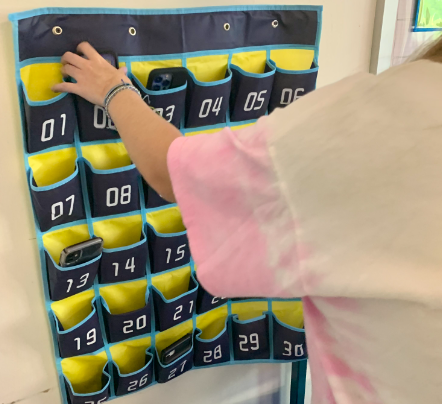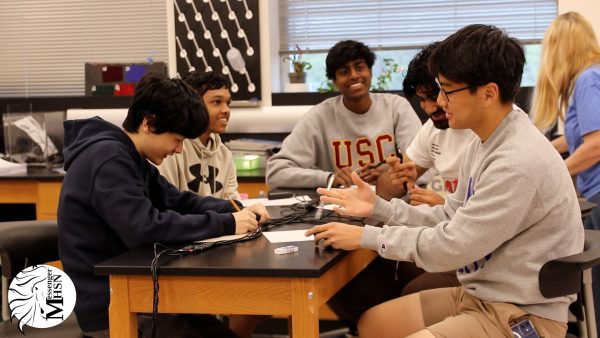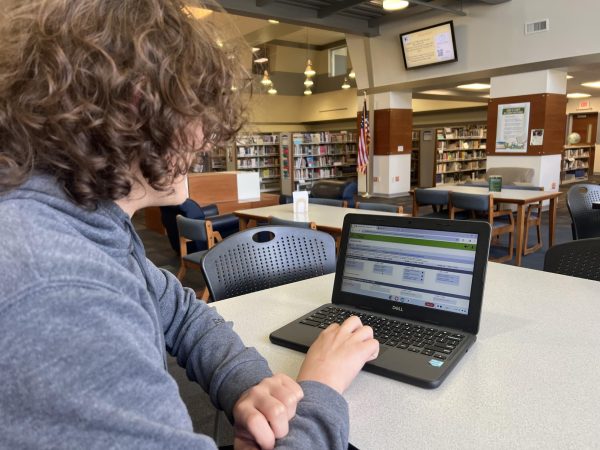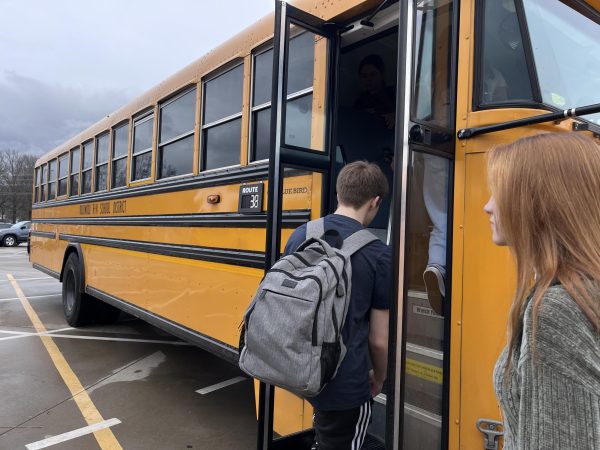MHS Sees An Increase In Phone Cubbies

Media by Aubrey Lacavich
Breanna Boevingloh puts her phone in the caddy before the start of class.
Janet Drabant, Spanish teacher, has started the school year again, by implementing phone caddies. To limit the number of distractions in the classroom, students put their phones in a caddie at the beginning of class and are allowed them back after the bell rings.
“I find that students are more interested in their phones and texting or checking their emails than paying attention to class, so I removed the distraction,” Drabant said.
Although phone cubbies have shown improvements in Drabant’s class, she is still seeing some problems arise.
Drabant found that students were able to listen to music through their Airpods and control it on their Apple watches.
Phone caddies have become popular in the history wing. Breanna Boevingloh, junior, has to put her phone away in Psychology with Mrs. Richardson.
“I mean students are on their phones sometimes, but they still pay attention, so I don’t fully understand why we have to put them up,” Boevingloh said.
I find that students are more interested in their phones and texting or checking their emails than paying attention to class, so I removed the distraction.
— Janet Drabant
Katherine Bauman, history teacher, said phones are increasingly a form of distraction in the classroom.
“Even though putting phones up still has not eliminated the distraction, it’s one less battle I have to fight in class,” Bauman said.
Bauman’s government students are required to put their phones in the caddy at the start of class and then they cannot touch them until the bell rings, which is a rule in most classrooms that use the caddy. She doesn’t require her AP European students to put up their phones, except during tests and quizzes.
“The expectation is higher for them to not be on phones, but engaged,” Bauman said. “The bar is set so high that they don’t have time to be on their phones during class.”
Bauman said virtual learning due to COVID-19 has caused many students to have a constant attachment to their phones. In her experience, last year was a constant struggle with the distraction and it caused her to fully implement the caddy.
History used to be my worst subject last year, but this year I feel like it is getting way easier because I don’t have any distractions.
— Riya Kothakota
Kathleen Drissell, ASL teacher, doesn’t use caddies because she wants students to learn self control on their own.
“You might have that temptation next to you and you still have to get over that and put it away,” Drissell said.
Drissell said phones are a problem during instruction and she doesn’t allow them then, but she does allow students to listen to music during independent work.
Riya Kothakota, sophomore, has to put her phone away in Claire Katsev’s World History class.
“History used to be my worst subject last year, but this year I feel like it is getting way easier because I don’t have any distractions,” Kothakota said.
She said having no access to potential distractions helps students learn better and receive better results in class.
According to the Marquette Handbook, “Classroom teachers and building administrators will determine when and how personal technology devices can be used.” Phone caddies are protected by the handbook, and teachers are allowed to use them.
Elijah Trotta, sophomore, said it’s unfair to take away personal property, although he understands where teachers are coming from.
“If you have a whole bunch of friends in your class, phones can be distracting,” Trotta said. “But I don’t see what’s wrong with listening to music on your own.”
Your donation will support the student journalists of Marquette High School. Your contribution will allow us to purchase equipment and cover our annual website hosting costs. You may become a PATRON by making a donation at one of these levels: White/$30, Green/$50, Blue/$100. Patron names will be published in the print newsmagazine, on the website and once per quarter on our social media accounts.

This will be Aubrey's 3rd year with the Messenger. This year she is a Sports Editor. She is involved in the Environmental Club, and the Marquette Orchestra....











